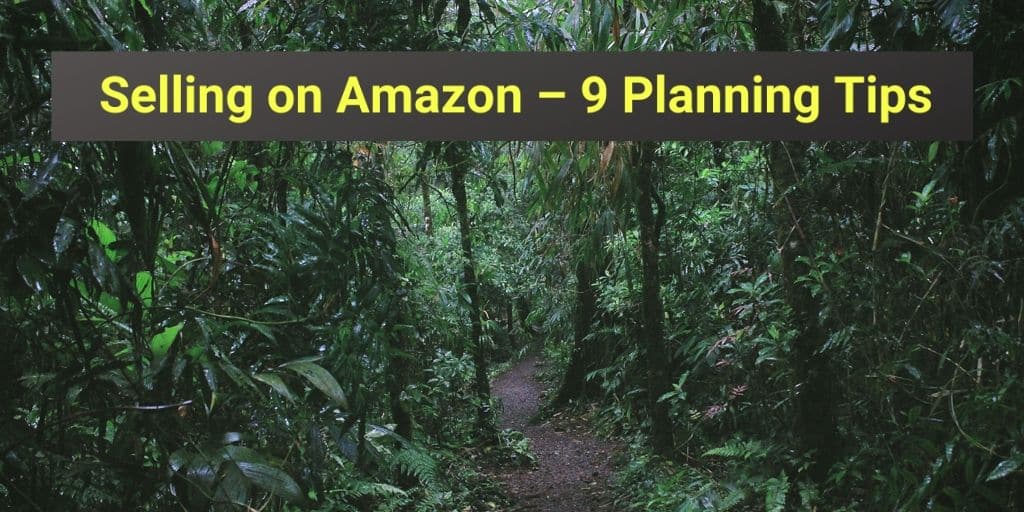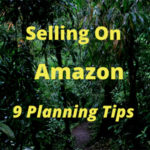You’re all ready to begin selling on Amazon and grow your business. Excellent! One question before you start: Are you really ready?
There is a lot of opportunity and a potential huge market on Amazon. During July 2019, Amazon.com had almost 2.65 billion combined desktop and mobile visits. As of June 2019 there were an estimated 105 million US Amazon Prime subscribers.
You can find numerous “get-rich-quick”,and “anybody-can-make-a-fortune-selling–on-Amazon” blog posts and books. However, selling on Amazon may not be quite as easy as it sometimes seems, regardless of how great your products are. Here are 9 planning tips to consider when launching an Amazon store.
1. Amazon Selling Goals
Let’s start with the basics – why do you want to sell on Amazon and what do you want to sell? Having a clear handle on the goals, motivation, time frame, management time required, budget, and the number and variations of products you want to sell is a solid starting point.
Evaluating all costs, price points, margins, anticipated sales volumes and work effort required prior to jumping in will help avoid surprises after the fact. Understanding the clear differences between selling via Amazon FBA (Fulfillment by Amazon), FBM (Fulfillment by Merchant) or through Amazon Vendor Central will help your business to select the optimal method.

2. Who is your competition on Amazon?
Your competitors on Amazon may be minimally or significantly different than those encountered when selling through a website, a retail store, other ecommerce sites such as eBay or Etsy or to wholesales customers.
Understanding competitors’ products, selling prices, product size, bundles, approximate monthly sales, and their number and quality of reviews is very useful information for positioning and planning. Also useful to determine if your main competitors are utilizing Amazon Prime, non-Prime free shipping, and participating in Amazon’s Subscribe-n-Save program.
Amazon’s Best Seller Rankings and Top 100 selling products can be very useful in identifying potential competitors. This data is available for categories and sub-categories. It’s also important to remember that your competitors can change, sometimes frequently. Monitor your competitors on Amazon regularly and adjust as needed.
3. How will you gain visibility for your products and your Brand?
There are millions of products being sold on Amazon. A huge number of products for sale attracts a huge number of buyers to the Amazon platform. It can also mean that your products get lost in the crowd. Rising above the noise level is crucial for visibility in the Amazon marketplace. If potential customers don’t see your products or cannot find them easily it will have a significant impact on your sales.
Amazon provides a number of effective Amazon marketing and advertising programs. These opportunities include Amazon Sponsored Product Ads (PPC), Amazon Deals, discount coupons and promotions programs that can be used both on Amazon and off of Amazon (discount codes) and within Amazon product listings.
Non-Amazon marketing efforts such as email marketing, social media posts and ad campaigns, other digital advertising channels can also be effective in driving traffic to your Amazon store and Amazon product listings. Studies have shown that traffic directed to Amazon from other sources can have a positive effect on your rankings and ratings. Especially when this traffic converts to sales.
4. How does an Amazon store complement your existing sales channels?
For many businesses Amazon can be a great complement to an existing ecommerce website and a retail presence. For small businesses having Amazon pack and ship single unit orders can be more efficient than doing it yourself. At the same time you don’t want to have your website compete directly against your Amazon sales and marketing efforts.
Another consideration is if you are selling Wholesale. Are you selling products wholesale to businesses that resell or repackage your products? Are they selling your products on Amazon under your name or theirs? It’s best to avoid any form of channel conflict or confusion with your products and brand on Amazon due to multiple sellers listing and describing your products differently or showing widely different prices for the same item.
Amazon also provides an opportunity for selling internationally. Beyond the US, Amazon has a number of international marketplaces. For the right products and brand this could open up a whole new set of sales opportunities.
From a shipping perspective Amazon Prime can speed up delivery of your products. For an annual fee Prime members receive free 2-day shipping, free same-day and 2-hour delivery in select areas, and reduced cost 1-day shipping.
5. What is your marketing budget for growing sales on Amazon?
This can be a stumbling block for small businesses in particular. Having a strategy, plan and budget for marketing the products you are selling on Amazon is important for success. Simply creating products listings and then shipping products to Amazon to sell via FBA without any clear sales and marketing and advertising budget can make for a very bumpy ride along the Amazon road – see item #3 Visibility.
Understanding the marketing and advertising programs available to you on Amazon and how they will mesh with your existing marketing and advertising programs is important. You want to avoid the scenario where you have built your Amazon store, created your product listings, shipped product to Amazon and sales are non-existent so you shovel increasing amount of marketing dollars at Amazon without significant ROI.
Another aspect of a marketing budget is sending traffic to an Amazon store and product listings from other locations. These can include email marketing, social media postings and ads (discount codes & special offers), links in blog posts, traffic directed from your business website, and signs in a retail location.
6. What is your brand?
This isn’t a trick question. Sometimes smaller businesses don’t have a good handle on this. Do you have a clear definition of your brand, a brand strategy and a trademark? Through its Brand Registry program Amazon provides additional opportunities to Brands for marketing programs, advertising, visibility and analytics.
Unlike with a business’s ecommerce website or retail store you have less space to explain and present your brand on Amazon. The Brand Registry program helps overcome some of this with items such as Brand Stores, A+ Content, improved brand protection and powerful brand analytics.
Amazon Brand Stores is a DIY solution that allows brands to create single or multi-page Stores to showcase their brand value and full product selection. A Brand Store is mini website located on Amazon that provides a brand with a single area to showcase all the products they sell on Amazon. A Brand Store can be accessed via a single URL. A+ Content allows Sellers to richer product descriptions and put images, charts, videos and other text formats on their product’s description section.
7. How much work will be necessary?
How much work effort will be required for your business to be successful on Amazon? Selling on Amazon is not a “set it and forget it” environment. Between inventory management, setting up and monitoring advertising and marketing programs, changing competitors and levels of competition, seasonality of sales, and the continuing changes implemented by Amazon itself, your business presence on Amazon requires regular attention for optimal results.
With a set of quality products, a realistic budget, effective pricing, profitable margins, marketing driven visibility, and consistent inventory, you will have a shot at achieving success selling on Amazon. It’s important to have an understanding of the level of work effort these various activities will take and who will do them. And what tools are required to do these things efficiently.
8. Do you have the skills necessary for success on Amazon?
Assuming that you have been running your own business successfully for a while it is likely that you, your employees or your contractors have the necessary skills to run a business. If starting and running a business on Amazon is a new endeavor for you it is worthwhile to do a reality check on your skills.
While there are significant potential upsides to selling on Amazon it is not always as easy as some people make it sound. Do you have the skills to be successful selling on Amazon? If not, will you be hiring employees or contractors to fill in the gaps? Useful skills may include general business planning and set up, sales, marketing, technology, copywriting, PPC, financial analysis, and inventory management among others.
9. Is Amazon the right Sales Channel for you?
For a final reality check it might be useful to consider if Amazon is the optimal sales channel for your business to invest in at this time. Expanding beyond your current sales channel(s) and developing a broader multi-channel strategy can be a real plus for the right businesses.
In other words, are there other Sales Channels that are better suited, or more profitable, for your particular business than Amazon?
In weighing the pluses and minuses much can depend on your specific brand, products, budget and sales and marketing strategies. Some other important factors can include the level of competition your products may face, the number of competitors in your product niche, and the Amazon fees that are charged for size, weight and price of your products. These factors can directly impact your ability to sell profitably (you do want to make a profit, right?)
Amazon Seller Planning – Conclusion:
Which of these nine planning tips will help with your Amazon selling efforts? Amazon can be a very attractive opportunity for a business. During July 2019, Amazon.com had almost 2.65 billion combined desktop and mobile visits. As of June 2019 there were an estimated 105 million US Amazon Prime subscribers, up from 95 million in June 2018. In the second quarter of 2019, 54 percent of units sold on Amazon were sold by third-party sellers.
Amazon presents a lot of opportunity, a potential huge market and many Amazon-specific tools and marketing programs to help grow your sales. Hopefully the nine items above have been useful is assessing if you have done your preparation. As Benjamin Franklin said “By failing to prepare, you are preparing to fail.”
HANDPICKED RELATED CONTENT From Our Blog
Ecommerce Business Trademark Registration – Basics to Know
Omnichannel Marketing Strategy – Does Your Business Need One?
Keywords, Search Terms and Keyword Phrases – Essential Everywhere Online
